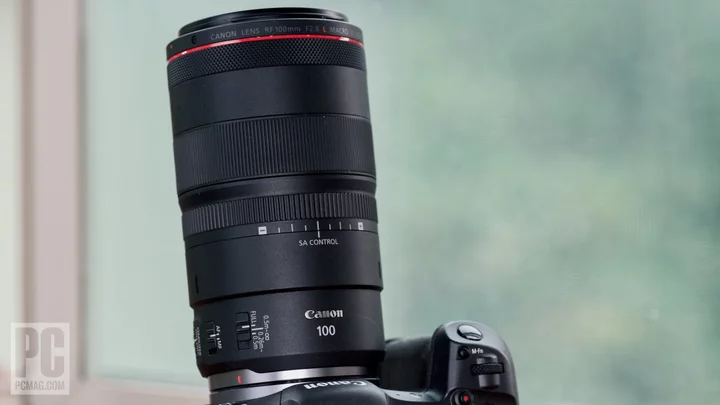Canon's ambitious $1,299 RF 100mm F2.8 L Macro IS USM lens captures subjects at 1.4:1 magnification and lets you create photos with an impressionistic, soft-focus look thanks to its unique optical formula. Those qualities, in combination with its sturdy construction, snappy autofocus motors, and handy stabilization system make this lens the one to get for extreme close-ups of insects, jewelry, and other traditional macro subjects. Just don't count out Canon's other close-focusing primes for more general use, such as the RF 85mm F2 Macro IS STM ($599.99). We haven't tested that portrait specialist yet, but it offers 1:2 magnification and optical stabilization for much less money.
It Does More Than Other Macros
The RF 100mm does a couple of things differently than other macro lenses. First off, it focuses extremely close for a 1.4:1 magnification rating at its nearest distance. Other lenses for the RF mount focus closer, including the Venus Laowa 58mm 2:1 macro we reviewed last year, but none offer the benefit of autofocus and optical stabilization like Canon's first-party entry. And then there's the spherical aberration (SA) control ring, which hugely influences the quality of pictures (discussed later).
(Credit: Jim Fisher)The lens is on the large side for a prime, at 5.8 by 3.2 inches (HD). It weighs a reasonable 1.6 pounds, but the long barrel makes it feel a little front-heavy. Canon markets, but does not include, a rotating collar that latches onto the barrel for better balance on a tripod, but the $199 add-on doesn't integrate a quick-release plate. Third-party options are available for less but aren't well-regarded. If you must have a tripod collar for the lens, it's worth it to spend more for Canon's.
As is typical for an L series lens, the 100mm Macro features dust and drip protection and uses a polycarbonate construction. The front glass features anti-smudge fluorine, so it's easy to wipe away water drops and fingerprints. The lens ships with a reversible hood and works with 67mm front filters.
(Credit: Jim Fisher)As for alternatives, Canon has yet to open up the RF mount to third-party lenses with autofocus, but Venus Optics offers several of its specialty manual focus macro lenses for Canon's mount. The 90mm F2.8 2x Ultra Macro APO, for instance, gets you a similar view, focuses even closer, and retails for only $499. If you prefer the convenience of autofocus, Canon has several close-focusing primes with 1:2 magnification. The RF 24mm F1.8, 35mm F1.8, and 85mm F2 are all part of its Macro line and cost between $500 and $600.
Stable Handling and Effective Autofocus
A long barrel might make for a front-heavy lens, but this leaves plenty of room for controls. The RF 100mm has three discrete rings for exposure control, manual focus, and SA adjustment. Canon doesn't put a function button on the barrel, however, even though there is plenty of room for one. The lack of a push-button for focus lock seems like a missed opportunity, too, as it's especially handy for macro photography. Rounding out the on-barrel controls is a trio of switches to set the focus limiter, change between manual and autofocus, and toggle optical stabilization.
(Credit: Jim Fisher)The control ring sits near the front of the barrel and uses a diamond texture that makes it easy enough to find by touch. It turns with audible clicks (silent operation is not available) to adjust aperture, EV, focus settings, ISO, and other sundries. You can change the function of this ring via your camera's menu.
A ridged focus ring sits mid-barrel and has a standard rubber finish. It turns with a pleasing amount of resistance and the focus motors respond without any discernible lag. These characteristics, in combination with the very long throw, make it easy to dial in minute adjustments to find the perfect point of focus for your shot. This is especially important for work at high magnifications, as the depth of field is razor-thin.
(Credit: Jim Fisher)Nano ultrasonic motors drive the focus system. The RF 100mm snapped from close-up to distant subjects in an instant with the EOS R5 in testing. Even so, the lens might hunt back and forth it if can't find a subject, especially at close focus distances. It's worth setting the focus limiter to look only for distant or close subjects for the best performance. I also recommend turning off tracking and sticking with single-focus mode rather than AI Servo continuous drive.
The lens focuses on subjects as close as 10.2 inches from the sensor, just a finger length from the front element. You must remove the lens hood to work at this distance, but the lens projects subjects at a larger-than-life-size magnification (1.4:1) and captures details that normal macro lenses can't. Its optical stabilization is also a benefit for macro work since it helps the viewfinder show a steady image. This makes for a much better handheld experience than with macro lenses that rely on a camera's in-body image stabilization (IBIS) since that mechanism kicks in only when you're actively taking a picture or rolling video—the viewfinder view remains shaky otherwise. For reference, Canon claims the lens is good for up to 5 stops of stabilization by itself, or up to 8 stops on a camera with IBIS.
EOS R5, f/8, 1/250-second, ISO 3200 (Credit: Jim Fisher)The close focus abilities come with two downsides: focus breathing and light loss. The RF 100mm noticeably changes its angle when it shifts the point of focus, so you get a much narrower view at close distances. Although focus breathing is usually more of a concern for video, it's something to note if you're experienced enough to employ focus stacking for your macro shots.
As for light loss, the RF 100mm doesn't always transmit as much as its F2.8 aperture indicates. It loses two stops of light at 1:1 magnification and drops by another third-stop to get to 1.4:1. That leads to an effective transmission stop (t-stop) of t/5.6 at 1:1 and t/6.3 at the closest focus. Setting the aperture smaller compounds the effect. So, if you're at f/8 for a 1:1 capture, you're actually closer to t/16. This is all to say that you might have to contend with high ISOs, even with the aid of a flash. When I used a Flashpoint MF12 two-light macro kit to snap a photo of a backyard dragonfly at f/8, for example, the camera set an ISO 3200 exposure. I took the image on a sunny day, albeit in a shady spot. If you are thinking about adding an extra light, a ring flash works best to avoid casting shadows on your subject.
Spherical Aberration Control
The spherical aberration (SA) control ring is just behind the focus control. When you set the ring to its middle, neutral position, the lens suppresses aberrations and delivers crisp, sharp photos like any other modern optic. An on-barrel lock keeps the SA ring set to neutral and is definitely worth engaging since it otherwise turns easily.
(Credit: Jim Fisher)If you want to experiment with aberrations, the ring offers four steps of adjustment in either a positive or negative direction. Both positive and negative settings deliver a soft-focus look that's most visible at wider apertures. The negative setting delivers a slightly wider angle of view and extends the soft look to the defocused highlights for generally smooth bokeh with a soft glow. The positive direction narrows the angle of view and dramatically introduces double edges to the bokeh for a kinetic, busy look. If you like bokeh with character, a positive SA setting is the way to go.
EOS R5, f/2.8, 1/100-second, ISO 100, SA +4 (Credit: Jim Fisher)Keep in mind that the SA effects are most visible at f/2.8, subtle at f/4, and hard to notice at f/5.6-8. Enabling these effects also trips up the autofocus system, so expect the lens to hunt back and forth. Overall, I found the SA control to be a nice bonus, one that lets you dabble with abstract photography when you want something different from the lens' otherwise clinical performance.
EOS R5, f/2.8, 1/125-second, ISO 250, SA -4 (Credit: Jim Fisher)RF 100mm F2.8 Macro: In the Lab
I paired the RF 100mm with the 45MP EOS R5 and Imatest software to check its optical performance in the lab, as typical, but also took a close look at real-world photos to get a handle on the character of its bokeh and overall rendering. The lens does well from a resolution standpoint and shows excellent contrast from f/2.8-8 (4,200 lines). The score falls to the very good range at f/11 (3,900 lines) and softens noticeably at the smallest supported apertures, f/16-32 (3,400-1,500 lines). The loss in resolution is an expected effect of optical diffraction but is a concern if you use smaller f-stops to get more of a macro subject in focus.
EOS R5, f/4, 1/125-second, ISO 640 (Credit: Jim Fisher)Distortion is absent, and the field of focus is appropriately flat for technical photography tasks. The optics show a bit of a vignette wide-open, but in-camera corrections compensate for it in JPGs. The vignette is also easy to correct manually or with a Raw profile in Lightroom Classic, our standard photo editing software for camera reviews.
I couldn't spot any signs of lateral chromatic aberration (CA), an effect that typically appears as purple fringing in high-contrast scenes, such as bare tree branches against a sky. There is a slight amount of the longitudinal variety (LoCA), however, which manifests as a false purple or green color in transitional areas just ahead or behind the plane of focus. This is a concern for detailed shots of watches, jewelry, and other reflective materials. If those are your bailiwick, an apochromatic macro like the Laowa 58mm F2.8 2x Ultra Macro APO ($499) is a better choice.
EOS R5, f/2.8, 1/250-second, ISO 100 (Credit: Jim Fisher)As mentioned, when the SA ring is set to neutral, the lens draws pleasingly soft backgrounds. Defocused highlights show soft edges with no visible false texture. The specular highlights toward the edges of the frame have a cat's eye shape when the lens is wide open, but they are pleasingly round at narrower f-stops. You can induce sunstars at the smallest f-stops (f/16-32); the 9-blade aperture makes for 18-point starbursts. Flare shouldn't be too much of a worry for most macro shots, but if you're using the lens for portraits with a strong light source in the frame, be mindful of some contrast loss and perhaps some green ghosting.
More Creative Control Than Other Macros
We tip our hats to Canon for doing something truly interesting with its first L Series macro for the EOS R mirrorless system. The RF 100mm F2.8 L Macro IS USM has the highest magnification rating of any autofocusing lens for the platform and its innovative spherical aberration control ring lets you influence the bokeh characteristics. Its optical stabilization and robust build quality come in handy for field work, too. Specialists can likely find a reason to spend for this lens given all of the above and its excellent image quality, but more casual creators who want to try macro photography are better off with Canon's RF 24mm, 35mm, or 85mm Macro primes since they cost less and offer more versatile focal lengths.









